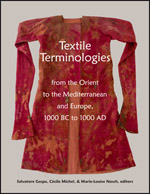Centre for Textile Research
Date of this Version
2017
Document Type
Article
Citation
In Textile Terminologies from the Orient to the Mediterranean and Europe, 1000 BC to 1000 AD, ed. Salvatore Gaspa, Cécile Michel, & Marie-Louise Nosch (Lincoln, NE: Zea Books, 2017), pp. 91-106.
doi:10.13014/K2416V6Z
Abstract
What did sheep shears in the 1st millennium BC Babylonia look like? We are not sure. Many cuneiform texts were written about textile work in Babylonia, but it was largely about administration or accounting. There were hardly any descriptions of the actual tools and processes. In this article we go back over the words, the iconography, and the archaeology in an attempt to find these missing descriptions. This study is limited to Babylonia during the 1st millennium BC, and this period correspond to a state of the Akkadian language, called Neo-Babylonian. At these times, major evolution took place. Mesopotamia entered in the Iron Age at the end of the 2nd millennium BC. Empires were built (Neo-Assyrian 911-610 BC, Neo-Babylonian 610-539 BC BC, Achaemenid 539-330 and Hellenistic 330-64 BC). Most of the cuneiform documentation of that period discovered by the archaeological excavations is dated from the “long 6th century BC”.2 At these times, Babylonia enjoyed an economic growth, longdistance trade developed, and the temples has an important economic weight.3 All these factors induce changes in the textile craft that are visible through an analysis of the vocabulary.
Textile tools were objects of everyday life, they were handled manually to transform the raw materials into finished woven products. They included all the implements used at different stages of fibre preparation, spinning, and weaving, as well as dyeing, washing, decorating and the repair of fabrics. An approach that combines the study of vocabulary of tools with the study of action verbs related to textile manufacturing can bring information about the techniques known in 1st millennium BC.
In Babylonia, during the 1st millennium BC, the textile craft was well-developed. Textiles were widely used in transportation, in home furnishing as well as for clothing. Common domestic production and luxury production both existed with the former being much less documented than the latter. Luxury production was organized by the temples, and probably also by the palaces.4 Wool was the most commonly used raw material.5 Flax was rare but present, and cotton appeared at these times in Babylonia.6 Special products like Egyptian flax, purple wool or special dyes, especially destined for luxury production, were imported through long distance trade.7 Manufacturing techniques were complex: the luxury textiles were adorned with metal appliqué, tassels, and embroidery. 8 The vocabulary of tools and action verbs dealing with textile production gives some information about the different tasks accomplished by the textile craftsmen, and about the techniques they mastered.
Important works about textile tools in Mesopotamia include the book by Catherine Breniquet Essai sur le tissage en Mesopotamie and the articles by Eva Andersson Strand, Agnete Wisti Lassen, and Caroline Sauvage.9 Using the context of these previous works supported by the Neo-Babylonian documentation, the question is how studying tool terminology and action verbs can improve our understanding of the function of the textile production in 1st-millennium BC Mesopotamia. Does textile terminology reveal evolutions at this late period of Mesopotamian history?
Included in
Ancient History, Greek and Roman through Late Antiquity Commons, Art and Materials Conservation Commons, Classical Archaeology and Art History Commons, Classical Literature and Philology Commons, Fiber, Textile, and Weaving Arts Commons, Indo-European Linguistics and Philology Commons, Jewish Studies Commons, Museum Studies Commons, Near Eastern Languages and Societies Commons, Other History of Art, Architecture, and Archaeology Commons


Comments
Copyright © 2017 Salvatore Gaspa, Cécile Michel, & Marie-Louise Nosch. Photographs copyright as noted.